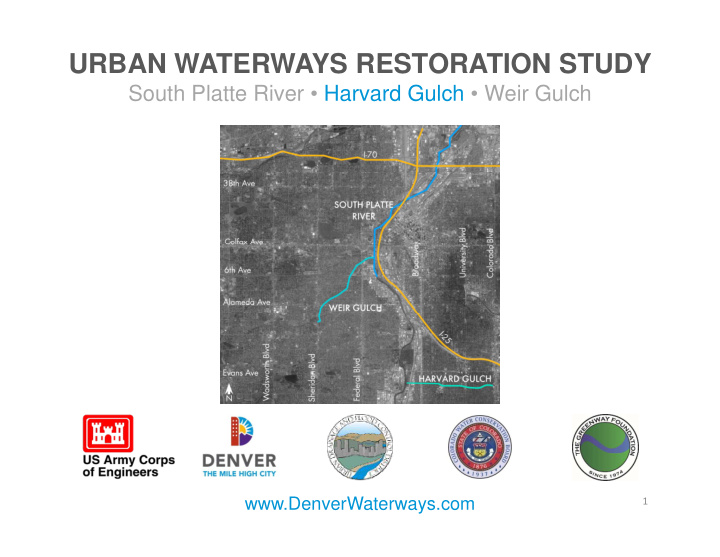



URBAN WATERWAYS RESTORATION STUDY South Platte River • Harvard Gulch • Weir Gulch www.DenverWaterways.com 1
Study Sponsors 2
Long term Schedule Feasibility Study Feasibility Study Secure Federal Secure Federal D Design & Construction i & C t ti 3 years Funding 6-12+ years Complete 2017 Min. 2 years 3
Tonight’s Agenda 1. Overview of Study 2. Review Existing Conditions 3. Present Potential Ways to Meet Study Goals 4. Present Next Steps 5 5. Gather Feedback G th F db k 4
Study Area Harvard Gulch Harvard Gulch sity Blvd ado Blvd dway Broad Univers Colora Evans Ave 5
Other Denver Projects in the Area Harvard Gulch Harvard Gulch • Grant Frontier Park • Denver Water Irrigation Conversion to Reclaimed Water at Harvard Park and Golf Course (Pond Improvements) p ) 6
Study Goals Harvard Gulch Harvard Gulch Primary Goal: Reduce Flood Risk Secondary Goal: Ecosystem Restoration y y Create a Healthy Waterway 7
Study Goals Harvard Gulch Harvard Gulch Photos: The Greenway Foundation C Complementary Goal: Recreation l t G l R ti 8
Public Input to Date Primary Goal: Reduce Flood Risk • General feedback of the importance of reducing the flood risk General feedback of the importance of reducing the flood risk • Bible Park is a good example of Detention Secondary Goal: Ecosystem Restoration • Preference for natural treatment (less concrete channels) • Natural Vegetation to Support Habitat Natural Vegetation to Support Habitat Complementary Goal: Recreation • Education Opportunities Education Opportunities • Improve trail connectivity Comments & Responses are on the website DenverWaterways.com 9
Existing Conditions Flood Risk • 860 structures in 500-yr floodplain 860 t t i 500 fl d l i • Population at risk of approximately 2,500 people • Current system designed to handle 10-25 yr event y g y 10
Existing Conditions Fl Flood Risk d Ri k St t Race St Gilpin 11
Existing Conditions Ecological Ecological Development impacts have caused a reduction in the quantity, distribution, and functional quality of riparian and wetland habitat quality of riparian and wetland habitat 12
Existing Conditions Low Functioning Wetland & Riparian Habitat Low Functioning Wetland & Riparian Habitat • Changes in adjacent uses (urbanization) • Lack of connectivity for migration • Increased erosion • Increased erosion • Lack of native vegetation 13
ALTERNATIVES Alternative 1: No Action Alternative 1: No Action Alternative 2: Open Channel - Flood Risk Reduction Focus Alternative 3: Open Channel - Ecosystem Focus Alternative 3: Open Channel - Ecosystem Focus Alternative 4: Storm Pipe Alternative 5: Detention Alternative 5: Detention Alternative 6: Non-Structural 14
Alternatives – Cross Section Depictions 15
ALTERNATIVE 1 No Action 16
ALTERNATIVE 2 Grass-Lined Channel - Flood Control Focus 17
ALTERNATIVE 3 Wetland Channel - Environmental Focus 18
ALTERNATIVE 4 Storm Pipe Alternative 19
ALTERNATIVE 5 Detention Area Alternative 20
ALTERNATIVE 6 Non-Structural Alternative • Elevation • Relocation/Buyout/Acquisition • Berms and Floodwalls • Dry Floodproofing Dry Floodproofing • Wet Floodproofing 21
Alternatives – Reach 1 Logan St to S. Platte River Enlarge Wesley St storm pipe or Add secondary y storm pipe along Iliff Ave Open channel along Iliff Ave with storm pipe under Santa Fe Dr 22
Alternatives – Reach 2 Ogden St to Logan St Multiple detention areas Multiple detention areas linked and drained with storm pipes Wide channel supporting habitat 23
Alternatives – Reach 3 Downing St to Ogden St g g Narrow grass-lined channel; Narrow grass-lined channel; Wide channel supporting habitat; Wide channel supporting habitat; flow split within Downing St flow split within Downing St storm storm pipe pipe 24
Alternatives – Reach 4 Race St to Downing St Narrow Narrow grass-lined channel Wide channel supporting ti habitat 25
Alternatives – Reach 5 Clayton St to Race St Narrow grass-lined channel Wide channel supporting supporting habitat 26
Alternatives – Reach 6 Colorado Blvd to Clayton St Narrow grass-lined channel Wide Wide channel supporting habitat 27
Selection Criteria Flood Risk Reduction Benefits and Costs Reduction in Risk to Loss of Life Reduction in Risk to Loss of Life Impacts/Benefits to Habitat Impacts/Benefits to Recreation p Are these important to you? Any others? 28
Study Outcomes & Schedule Step 1: Understand existing conditions Spring 2015 Step 2: Evaluate a broad range of options Early 2016 Step 3: Selection of Preferred Plan • Public Meeting #3 Late 2016 Propose a preferred plan • Corps & CCD Selection of Preferred Plan C & CCD S l ti f P f d Pl L t Late 2017 2017 29
Long term Schedule Feasibility Study Feasibility Study Secure Federal Secure Federal D Design & Construction i & C t ti 3 years Funding 6-12+ years Complete 2017 Min. 2 years 30
Feedback & Next Steps Collect your feedback: • Visit the stations tonight & write comments on the plans • Provide comments online www.DenverWaterways.com • Call 311 Project Team Next Steps: • Project team evaluation of the range of options • Project team evaluation of the range of options • Recommend a preferred option based on selection criteria • Propose preferred plan at public meeting – Fall 2016 Propose preferred plan at public meeting Fall 2016 Tiffany Vanosdall- USACE Study PM Selena Klosowski Denver Study PM Selena Klosowski- Denver Study PM Jeremy Hamer – Denver Floodplain Manager 31 www.DenverWaterways.com
Q & A www.DenverWaterways.com 32
Recommend
More recommend